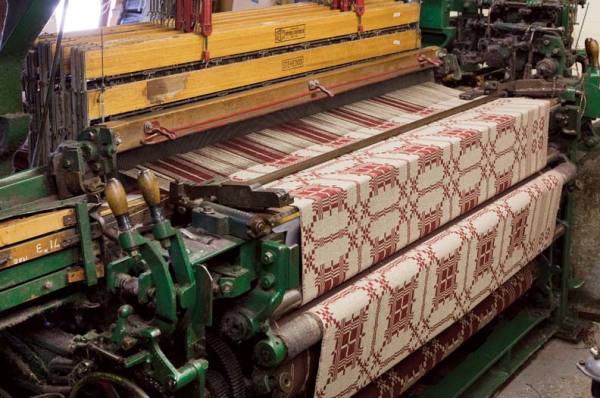
The textiles are woven on old looms. Many of the company’s designs have been featured in period films.
Nineteenth-century British textile designer William Morris said, “Have nothing in your houses which you do not know to be useful or believe to be beautiful.” Unable to find furnishings that passed muster for his own residence, the founder of the Arts & Crafts movement established Morris & Company, a firm that offered its customers objects of interesting design, magnificent color, and sound workmanship. Morris, a man of impeccable taste, encouraged methods of hand production over machines.
Today the same concerns for quality and integrity in manufacturing preoccupy Family Heir-Loom Weavers in York County, Pennsylvania, one of very few mills left in the country that produce historically accurate reproduction textiles. Started by David and Carole Kline in 1983 and now run by their son, Patrick, the company embodies the family’s shared passion for American history; two of David’s grandsons also work there.
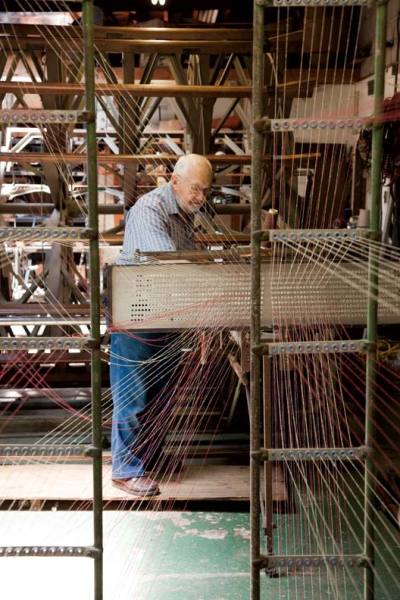
David Kline works the loom to create period-inspired textiles
The Klines’ ingrain and Venetian rugs appear in Hollywood movies, furnish early U.S. presidents’ homes, and are sought after by curators of prestigious museums for a variety of restoration projects. Among commissions that flood in from all over the world was a recent request to weave carpeting for Kelmscott Manor, the summerhouse of aesthete Morris, who began designing carpets himself in the mid-1870s. Albeit not made by hand, Family Heir-Loom goods are woven on old-style looms, one dating back to the Morris era. To reproduce the old fabrics, you have to have an old-style loom; the speed is a lot slower, but the quality is far better.
“They go around rescuing looms so they can do things you can’t do on modern looms,” says Linda Eaton, director of collections and senior curator of textiles at Winterthur Museum and Estate, the former home of Henry Francis du Pont, which houses one of the most important collections of Americana in the country. Eaton first worked with the Klines in the late 1990s, and they continue to be her go-to source for historically accurate reproduction carpets. “They have done some wonderful ingrains,” she remarks of the flat-woven rugs that were popular and prevalent in America from the late eighteenth until the early twentieth century. They weave the carpet just as it was done originally, in 36″-wide strips that are hand-seamed together.
Started on little more than a hunch, the business now enjoys an international reputation for historical authenticity. Oscar-winning costume designer Ann Roth, who often works with film director Steven Spielberg, “is a stickler for accuracy,” notes 81-year-old David Kline, as is Spielberg himself. They have ordered several times from the Klines for movies that include Amistad and the soon-to-be-released Lincoln, where the Family Heir-Loom carpets appear in the White House scenes.
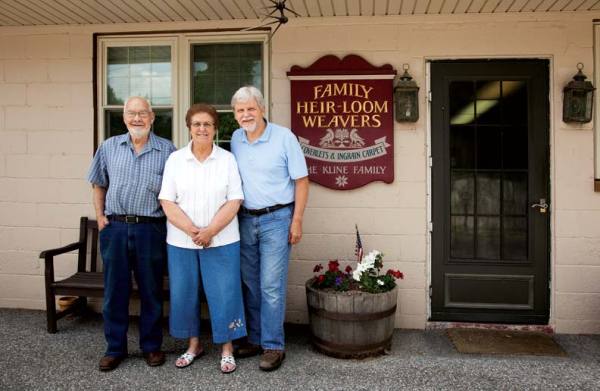
David, Carole, and son Patrick run this family-owned business.
“We don’t have much competition,” David says of the business they started on a shoestring at a time when he was unemployed. A former silk loom repairman, David says a fragment of an old jacquard coverlet that once belonged to his great-grandmother was his inspiration: “No one was making coverlets.” He and Carole appreciate antiques and noticed that people would pay handsomely for nice ones. “I figured that the same collectors would have the money to pay for a coverlet with their name on it,” explains David. So he pocketed the piece of cloth that was among items destined for the dump. Nearly a decade passed before he brought it to Philadelphia College of Textiles & Science (now Philadelphia University) to have the yarn analyzed so he knew what size to use.
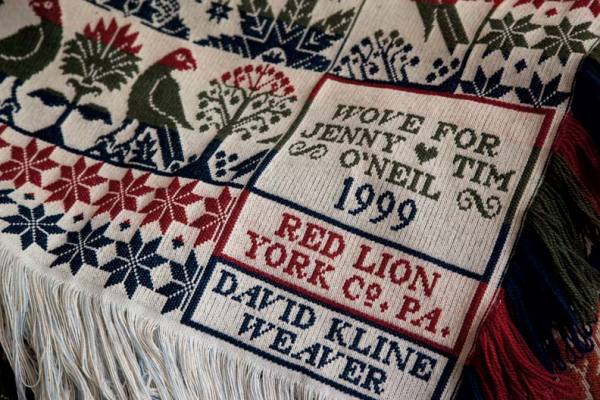
David draws inspiration from jacquard patterns and weaves his name into each piece.
Jacquard, a technology invented in France in the early 1800s, enabled weavers to advance from fairly simple geometric patterns to more complex designs, like flowers and intricate borders. The style, which had become old-fashioned by the late 1800s, was ripe for a revival when the Klines introduced their reproduction coverlets, woven in two halves and hand-seamed together, just as they were in the 1800s. Adding to their appeal is a signature block in one corner of every coverlet that reads, “Wove by David Kline/Red Lion/PA,” and the customer’s name as well as the date, if desired.
Not long after taking 11 months to weave their first coverlet, the Klines filled orders for table runners, tablecloths, place mats, pillows, and other household items. Their entrance into the carpet-making business came in 1985, when a National Park Service historian who had purchased a coverlet asked if they could reproduce an 1840 carpet for Abraham Lincoln’s house in Springfield, Illinois, which was being renovated. Since then, the company that started out with two looms in an unheated workroom has made historically accurate carpets for eight other presidents’ houses, including those of George Washington and Ulysses S. Grant, as well as more than 75 other historic homes, museums, and sites such as Mark Twain’s boyhood home, Colonial Williamsburg, and Gracie Mansion, in addition to Winterthur.
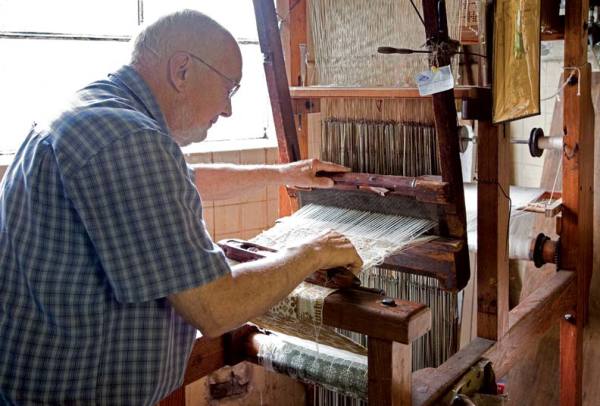
David purchased his first two looms in 1951. Today he has more than 40 looms and 30 employees.
Regardless of whether it is for a museum or a private home, the quality and accuracy of the carpets provide the customer with a way to bring the interior design of the home back to the period in which it was built. Many old private homes are furnished with Oriental carpets, but they’re not what was used at that time, points out David.
When David bought his first two looms in 1951, he hoped he could last until 1965. Now, 30 years later, there are 40 looms and 30 employees. Demand for the Klines’ products is such that sometimes they even have to turn away work.
“I’m grateful that they continue to be passionate about the things that they do,” says Winterthur’s Eaton. As a teacher in the Winterthur Program in American Material Culture, she advises many students regarding their theses that are related to textiles and clothing, and regularly brings her students to Family Heir-Loom Weavers to see how the work is done. “Weaving really isn’t rocket science,” she says, “but it’s hard to wrap your mind around the weaving process. Patrick and David can show us changes in technology and what that means. They are both such enthusiasts.”







